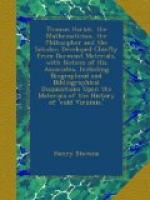Mr Torporley then, it is manifest, had in hand the papers and returned them, but it is not apparent what amount of labor he bestowed upon them. They do not appear to be properly arranged, nor have the waste papers been weeded out. From Protheroe’s list and other circumstances it is likely that nothing has been destroyed, except perhaps the Raleigh accounts and the Irish papers in the ’ canvas baggs.’ The papers were at Sion, and were placed in a trunk and delivered to the Earl, who left the Tower only sixteen days after Hariot’s death. They subsequently found their way to Petworth, another seat of the Earl, where the trunk and half of the papers still remain, in the possession of the Earl of Leconsfield, a branch of the Northumberland family. They are briefly described in this manner by Mr Alfred J. Horwood in the Sixth Report of the Historical Manuscript Commission for 1877, page 319, folio.
A black leather box containing several hundred leaves of figures and calculations by Hariot. A large bundle of Hariot’s papers. They are arranged in packets by Professor Rigaud. Spots on the Sun. Comets of 1607 and 1618. The Moon. Jupiter’s Satellites. Projectiles, Centre of Gravity, Reflection of bodies. Triangles. Snell’s Eratosthenes Batavus. Geometry. Calendar. Conic Sections. De Stella Martis. Drawings of Constellations, papers on Chemistry and Miscellaneous Calculations. Collections from Observations of Hannelius, Warner, Copernicus, Tycho Brahe. On the vernal and autumnal equinoxes, the solstices, orbit of the Earth, length of the year, &c. Algebra.
A similar collection, but not yet arranged, catalogued, numbered or bound, is carefully preserved in the Manuscript Department of the British Museum (Additional, 6782-6789), in eight thick Solander cases, probably as much in bulk as the Petworth papers. They were presented to the Museum by the Earl of Egremont in 1810. Why the two collections were separated does not appear. The Museum papers contain much that is waste, but much also that is of importance equal probably to those at Petworth. Mr Torporley was in effect appointed by Hariot his literary and scientific editor under the direction of the Executors. No papers were left ready for publication. It must have required great study and labor to master them sufficiently to pen for public use such doctrine or science as belonged to them. Torporley lived in Shropshire, but a few years after Hariot’s death he retired from his rectorship and removed to London,taking rooms in 1630 at Sion College in London Wall, when that institution was first founded. It contained then as now a library for the use of the Clergy, and a few suites of apartments for those who desired to reside on the premises. It never was a College or place of instruction, but a sort of guild or Clergyman’s Club. At this time Mr Torporley was about seventy years old. He died in his chambers at Sion College in April 1632, and was buried on the 17th of that month




